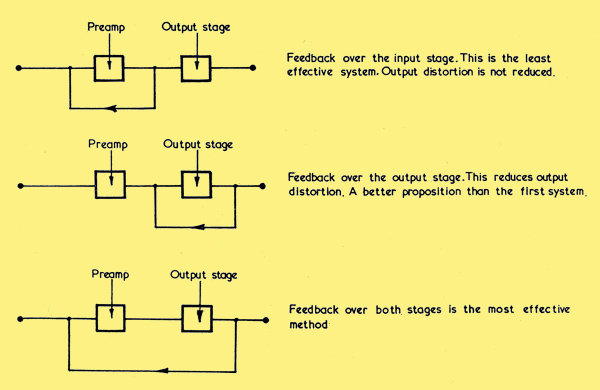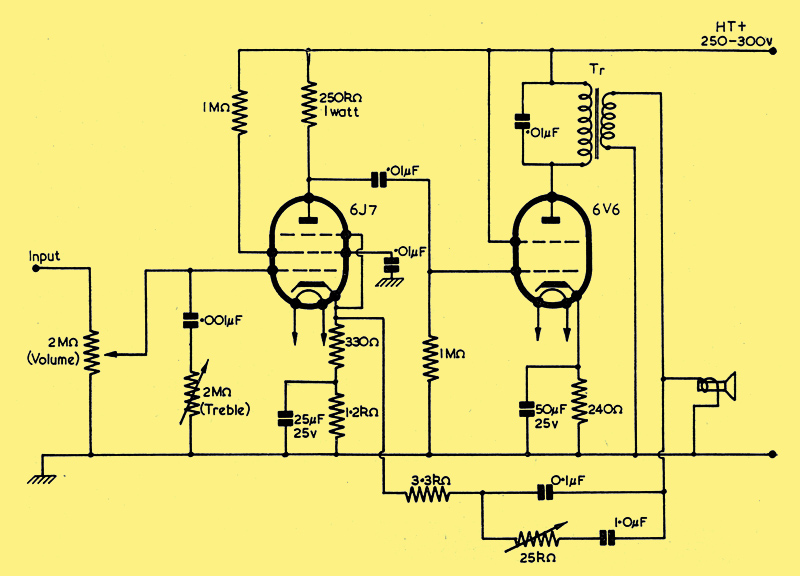|
A Miniature High Fidelity Amplifier
There is considerable interest in the high fidelity reproduction of records, particularly in view of the superb quality and virtually noiseless background obtainable from long-playing records. Unfortunately, the cost of modern high fidelity equipment, particularly when pre-amplifiers, tone control units and equalisers, to say nothing of loud- speaker enclosures and multiple speaker systems with crossover networks are included, is high. The constructor with a modest pocket must often feel the need for a medium priced amplifier which will give good results, without costly trimmings. Unfortunately there are very few low cost amplifiers or designs available.
The object of the 'Microamp' design was to evolve the simplest amplifier which would provide negative feedback for the advantages obtainable therefrom, and also include tone correction and/or equalising facilities for optimum reproduction of records. The cost was to be as low as possible, and in fact enable the home constructor to use pieces in stock, or even in the junk box, and still obtain reasonable quality even when using, say, a small surplus speaker rather than an expensive super high fidelity model. In fact, owners of super high fidelity speakers would normally be able to afford an amplifier to suit. However, the amplifier will, of course, feed a super high fidelity speaker if one is available.
After some thought, the amplifier was reduced to the ultra-simple line-up of just two valves, a 6J7 amplifier and a 6V6 output stage. If a modern crystal pick-up such as the ACOS types are used, then the stage gain of 120 obtainable with the 6J7 is some ten times more than is necessary to swing the 6V6 to full output. Accordingly negative feedback of from some ten to twenty dB may be applied with a consequent reduction of distortion.
As a study of some negative feedback designs will reveal, there are considerable stumbling blocks in the way of applying feedback. Multi-stage amplifiers using a heavy degree of feedback require quite advanced design if stability is to be achieved with a wide frequency response. In fact, the application of feedback to even a two- stage amplifier can be achieved in several ways as shown below.

Methods of feedback
Several two-stage amplifiers have been described in which feedback has been applied only in the pentode pre-amplifier. It is difficult to see the reason for this, as this is the least effective method of applying feedback. The output stage operates at high level, so distortion there is far higher than in the pre-amplifier, which has only to provide some ten volts or so of audio at the most. Hence the overall distortion is hardly affected in such an amplifier, where one is merely feeding slightly purer audio into a stage capable of appreciable distortion. The effect is that of a cupful of pure water in an ocean of sewage.
In other cases feedback is applied over the output stage only. This is helpful in reducing distortion. However, it is generally impossible to apply feedback from the output stage via the speaker transformer secondary. This is because, measured at the output secondary, the output stage, far from having a gain, may have a reduction in voltage as compared with the grid input, as the output transformer has a high step-down ratio. Thus with feedback over the output stage only, We must take output from the anode and not from the transformer output. However, feedback from the secondary winding helps to reduce transformer defects, an especially important point with single-ended amplifiers.
The most satisfactory method, therefore, is to use feedback over the whole amplifier from speech coil to input. This overall feedback reduces distortion irrespective of whether it arises in the pre-amplifier, output valve or output transformer. It is the customary solution in complex amplifiers, but is seldom applied to simple two-stage amplifiers of the economy type. Nevertheless, it is just as advantageous.
However, readers will quickly discern a snag or an apparent snag. Having thrown away surplus gain in negative feedback, we have no gain to spare for tone control circuits. As tone control circuits generally operate as attenuators of various sections of the audio spectrum, we need considerable 'surplus' gain if tone control is to be achieved. However, for record reproduction, top is boosted on the record. Therefore we can safely use a top corrector of variable attenuation to give the effect of top boost, correctly equalised top, or even top cut without sacrificing gain. This effectively disposes of the problem of top correction.
For bass correction, a different solution is adopted. The bass correction progressively decreases negative feedback in the bass, so that output rises in the bass region, and bass boost is achieved without sacrificing gain. Moreover, feedback increases as the frequency rises in the bass, and so harmonic distortion products being of higher frequency than the bass fundamentals will be fed back appreciably. Thus the value of feedback in reducing distortion is not lost to any great extent. So without going to any greater complication than two valves, the above tricks enable the best possible use to be made of such a simple combination.

Tr transformer to match 5,000 Ohms to 5 Ohms. All resistors are 0.5 Watt except the anode resistor of the 6J7.
The schematic above shows the circuit of the amplifier constructed to test the overall performance of such a circuit design. It is so simple that no layout is considered necessary, provided the usual simple precaution of keeping the grid circuit of the 6J7 well away from the anode circuit of the output is observed. The pick-up leads and 6J7 grid lead should, of course, be carried out in screened cable, and short leads used in wiring up the top corrector components in the input circuit. A simple power pack providing some 250 to 300 Volts at, say, 60mA will be perfectly adequate. In the writers case a general purpose power pack having a double 8μF condenser and smoothing choke was used, and the hum level (probably due to the hum reducing effect of feedback) was low.
No elaborate speaker system was used; in fact, a surplus 6 in speaker and transformer were used in a 'table top' miniature vented enclosure constructed for the occasion. The definition of both bass and treble was very satisfactory on both LP and 78 rpm discs when using a modern crystal pick-up. The equipment was loaned to the owner of a popular three-speed playing desk, who reported that he had discovered a previously unsuspected background treble register counter-melody on a favourite record that he had never noticed previously! While no exaggerated claims are made, the writer is confident that the suggested arrangement will give about the best possible results obtainable in a two-stage amplifier. It may be that the results will be surprising to those who suppose that 'high fidelity' is only possible with elaborate and costly equipments. Certainly it is a considerable improvement on the use of the usual domestic receiver for record reproduction. Owners of two-stage amplifiers not incorporating feedback may like to try modification to the circuit, if they have enough gain in hand to provide adequate negative feedback, as in many cases a considerable improvement in quality may be achieved. Moreover, where a large speaker adequately baffled or housed is available, results should be correspondingly improved.
|